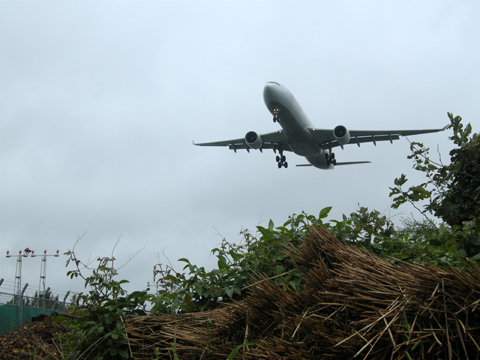A Farm in Toho
ii. Description of Project
This soundscape composition is assembled out of a series of recordings made over two weeks during September 2010 on a farm that is surrounded on all four immediate sides by the Narita International Airport complex. The farm is an organic small-holding with fields of fruit and vegetables, pens of pigs and a barn with egg-laying hens; it is the focus of the Wellcome Trust-funded “Air Pressure” project, an investigation of impact of the heard environment on human health, with the research conducted between environmental science, health science, anthropology and art. The composition compresses two weeks of listening and recording into ten short minutes.
iii. Listening
The composition begins out in the fields to the south of the farm dwellings, where a variety of creatures conspired to set the molecules of air vibrating: crickets, a brown hornet, cicadas, snorting pigs and chickens rattling in their cages as their drinking water drips into small troughs. The sound of distant helicopter introduces a more human register and we hear the two main farmers cutting aubergine and okra, their feet moving through soil made wet by overnight rain. A JAL 747 comes into land on Runway A before the acoustic scene shifts to the room where produce is wrapped, weighed and boxed, the planes continue to fly over the farm. A neighbouring farmer passes in his van from which amplified speakers protest against the airport; the farm’s utility truck starts up and we hear the whine of taxiing jets and a muffled take-off.
iv. Equipment
A variety of microphones were pressed into service here. The close-up recordings were captured with either a parabolic microphone connected to a cheap consumer hard-drive recorder (and its poorer circuitry is audible here) or a pistol-gripped mono mic working in tandem with a higher quality field recorder. The wider atmospheres were provided by either an M/S pair or by some Rode NT-4s, whose windshields were further insulated by wrapping them with acoustically absorbent cloth. In the majority of cases, the microphones were held by hand, although the Rodes (recording the longer sequence of fly-overs) were positioned on a tripod.
In parallel to my previous compositions, I have worked many, many tiny fragments of sound into something approaching coherence. Although there is very little processing of the original recordings – aside from some normalisation and some EQing – I am interested in using the falsehoods involved in sequencing and layering sound to deliver some kind of truth. The skylark that can be heard at 3.23 was actually recorded 6000 miles away from the farm in Toho. The motivation for including its circling call derived from the farmer telling us that it was one of the very few sounds he remembered from a time before the airport was constructed.
v. Bibliography / Phonography
Gaston Bachelard, “The Poetics of Space”, Boston: Beacon Press, 1994.
Francesco Careri, “Walkscapes: Walking as an Aesthetic Practice”, Barcelona: Editorial Gustavo Gili, 2002.
Angus Carlyle (ed.) “Autumn Leaves: Sound and Environment in Artistic Practice”, Paris: Double Entendre, 2007.
Angus Carlyle “Earlids and Brainlids: On Thoughts and Sounds”, in (eds.) Colin Davies and Monika Parrinder, “Limited Language: Rewriting Design”, Basel: Birkhauser, 2010.
Angus Carlyle “If You Were To Clap. If I Were To Listen,” in (ed.) Julian Weaver, “Relay,” Brighton: Finetuned, 2007.
Angus Carlyle, “Some Memories of Bamboo,” CD, Gruenrekorder, GR 53, 2009.
Einar Hansen, “The Fog Will Clear, The Snow Will Melt”, 2007
Yve Lomax, “Sounding The Event: Escapades in Dialogues and Matters of Art, Nature and Time”, London: I.B. Tauris, 2005.
Paul Shepheard, “The Cultivated Wilderness: Or What Is Landscape?”, London: MIT Press, 1997.
Rodaway, Paul, “Sensuous Geographies: Body, Sense, and Place”, London: Routledge, 1994.
Michel Serres, “Genesis”, Ann Arbor: University of Michigan Press, 1995.
Rebecca Solnit, “Wanderlust: A History of Walking”, New York: Viking Penguin, 2000.
David Toop, “Sinister Resonance: The Mediumship of the Listener”, London: Continuum, 2010.
Salome Voegelin, “Listening To Noise and Silence: Towards a Philosophy of Sound Art”, London: Continuum, 2010.
vi. Biography of Recordist
Angus Carlyle is a Joint Director of CRiSAP (Creative Research into Sound Arts Practice) at the University of the Arts, London. In parallel to a long-standing critical engagement with contemporary photography, his writing has tackled subjects as diverse as the suicide of situationist Guy Debord and the sense of place experienced by long-distance truck drivers. At the turn of the millennium, he edited the fashion and culture magazine, themepark, and has since edited the book Autumn Leaves: Sound and Environment in Artistic Practice for Double Entendre and compiled an award-winning album to accompany it.
His explorations of sound in artistic contexts have involved exhibiting at various galleries, appearing on CDs and performing. He co-curated the Sound Escapes show at Space in London in the summer of 2009 and his first solo album Some Memories of Bamboo was released by Gruenrekorder in the autumn of that year. The aesthetic qualities of the album reflect Angus’ enduring interest in how we humans inhabit our landscapes, a theme that is present in his creative writing, his photographic criticism and in his soundwork.
Like his work 51° 32 ‘ 6.954” N / 0° 00 ‘ 47.0808” W for the Sound Proof group show at E:vent or his work Sondagsmaler for the Relay group show, Some Memories of Bamboo involved spending a long time within the confines of one small geographical area. Like on those past occasions, listening was crucial and a lot of time was spent sat still with his ears open or spent wandering quietly, paying attention to the changes in sound from one footstep to the next.
